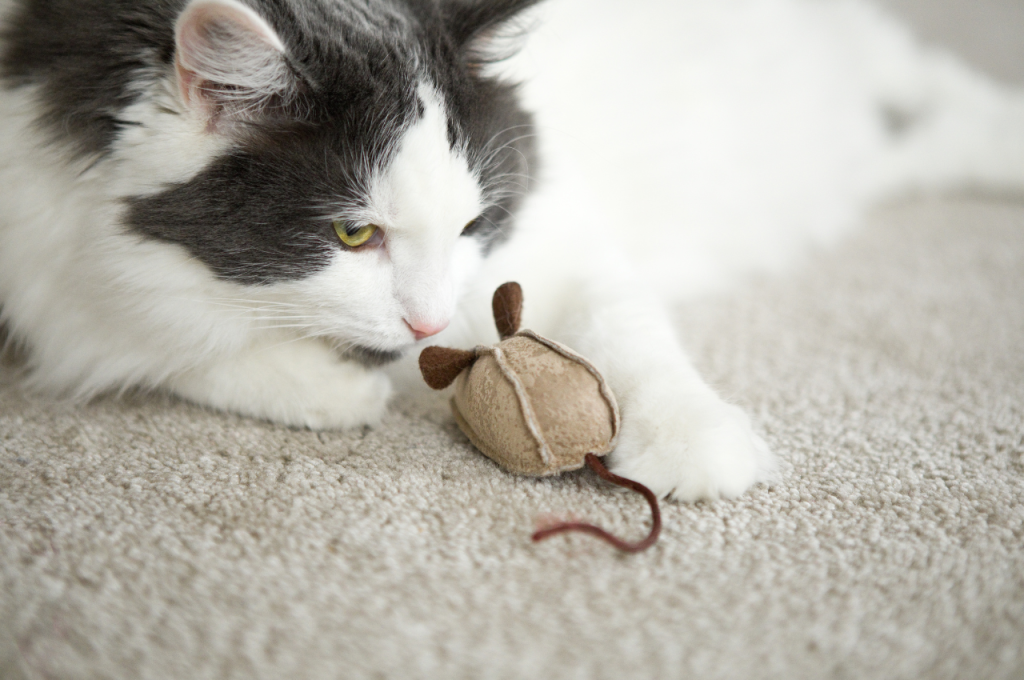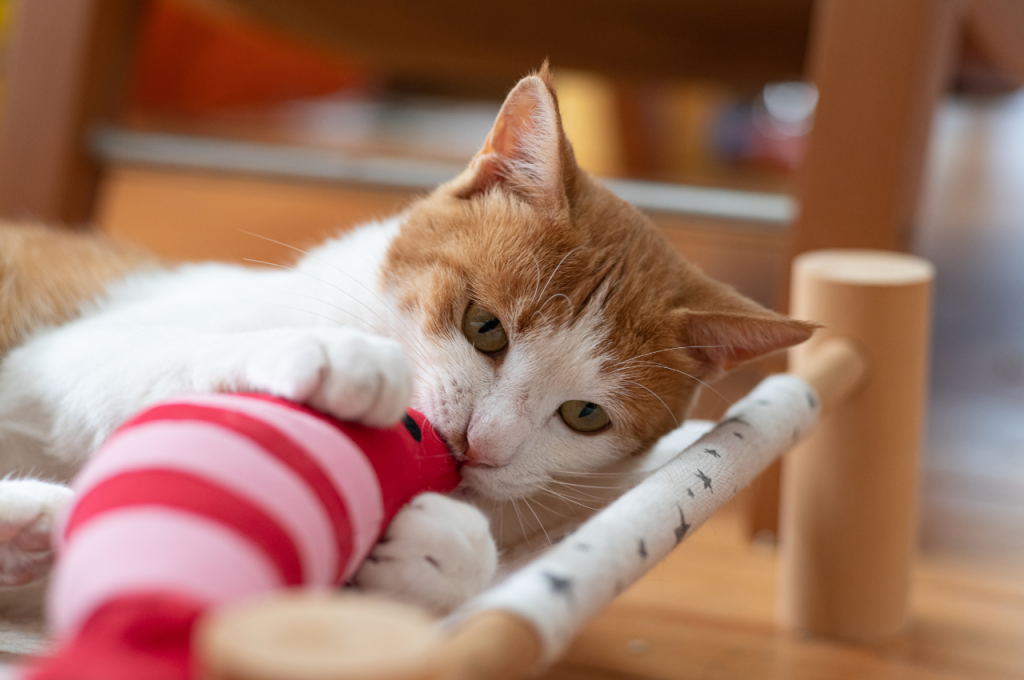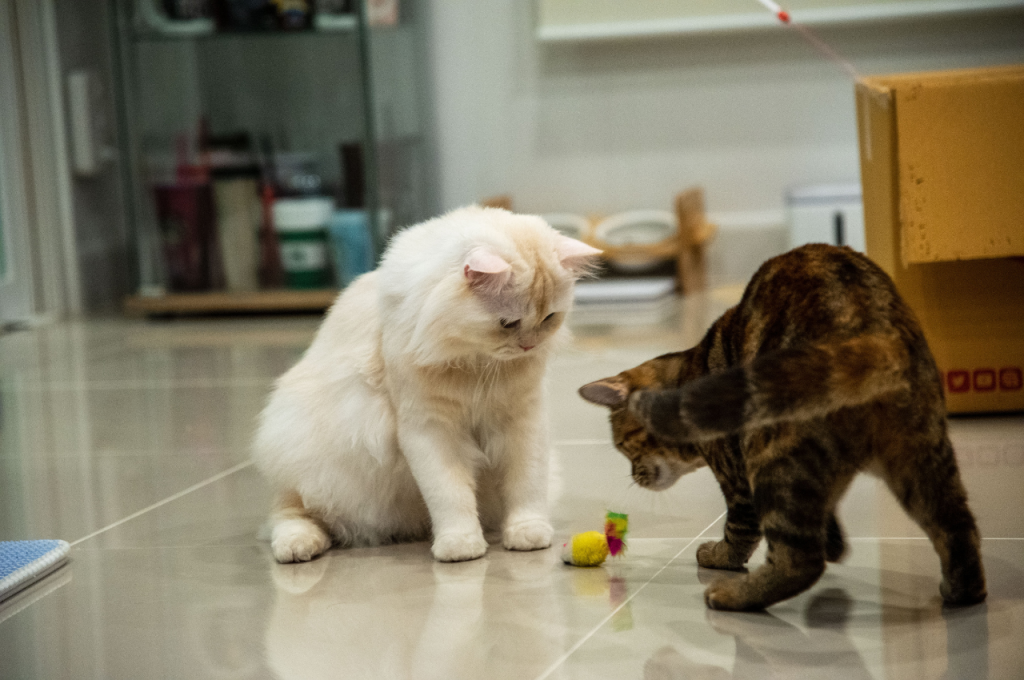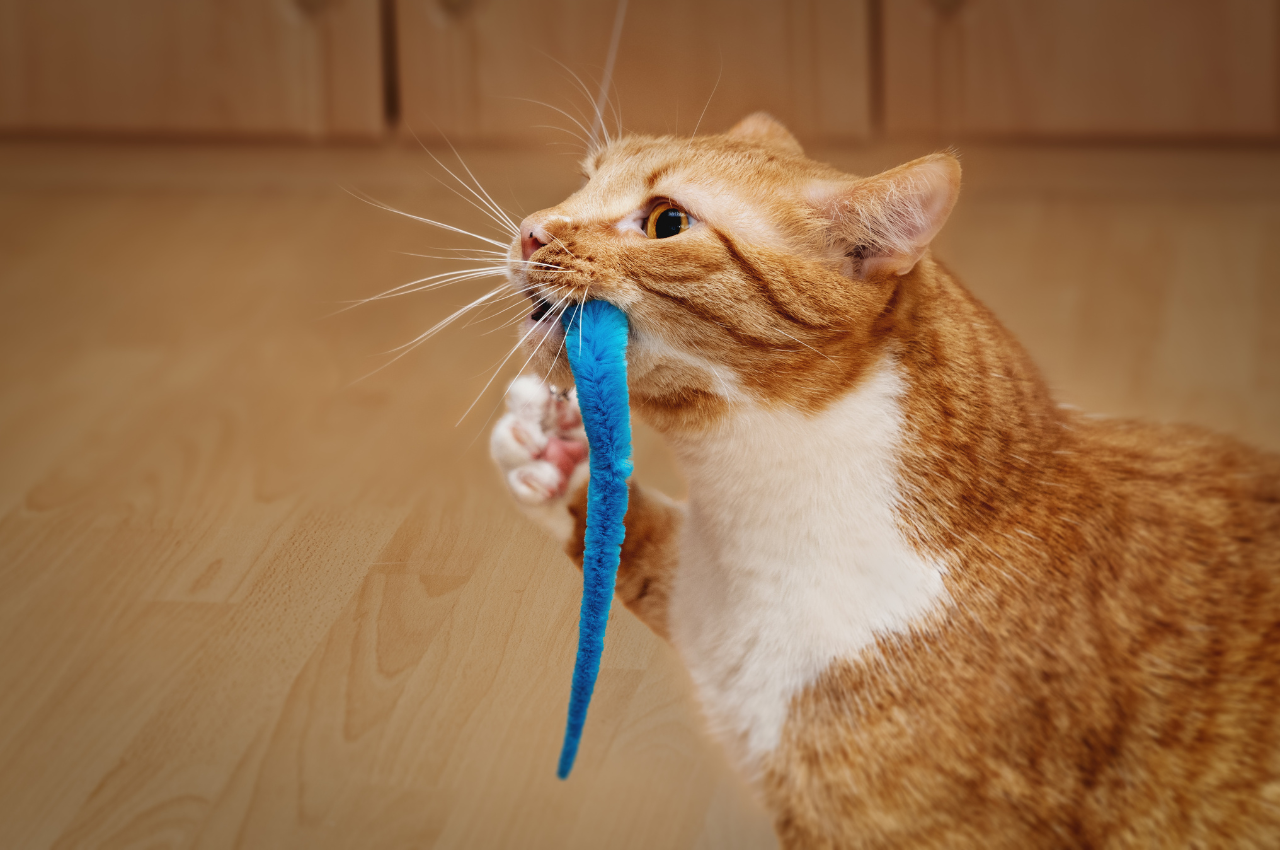To train a cat to fetch, start by using a clicker and treats to reinforce positive behavior. Gradually introduce the concept of fetching by tossing a small toy or object for the cat to retrieve.
Reward the cat with treats and praise when it brings back the item. Practice regularly and be patient, as it may take time for the cat to understand and engage in the game. Training a cat to fetch can be a fun and engaging activity for both you and your furry friend. While dogs are often associated with fetching, cats can also learn to play this interactive game. Teaching your cat to fetch not only provides mental stimulation but also strengthens the bond between you and your pet. However, it requires patience, consistency, and positive reinforcement.
In this blog post, we will explore effective techniques to train your cat to fetch, allowing you to enjoy hours of interactive playtime together. So, let’s dive in and discover the steps to successfully teach your cat this entertaining trick.
Introduction to Cat Fetching
Cat fetching is an activity where a cat retrieves an object, such as a small toy after it has been thrown by its owner. While commonly associated with dogs, many cats also enjoy this interactive game, which provides both mental and physical stimulation. Fetching taps into a cat’s natural hunting instincts, offering them a fun way to exercise and bond with their owner. Introducing your cat to fetching can enhance their playtime routine, improve their agility, and strengthen the human-cat relationship. With patience and the right motivation, such as treats or praise, most cats can learn to fetch and enjoy this engaging activity.

The Joy of Interactive Play
Playing fetch with your cat can be a delightful and rewarding experience for both you and your feline companion. It fosters a sense of engagement and strengthens the bond between you and your pet. Cats are intelligent creatures and engaging them in interactive play provides mental stimulation, physical activity, and a sense of accomplishment.
Benefits for Your Feline Friend
Training your cat to fetch offers numerous benefits. It encourages physical exercise, which is essential for maintaining a healthy weight and preventing obesity-related health issues. Additionally, fetching can fulfill your cat’s natural hunting instincts, providing mental stimulation and alleviating boredom. Furthermore, it can help reduce stress and anxiety, promoting overall well-being.
Preparation for Training
Preparing for training your cat to fetch is essential to ensure a successful and enjoyable experience for both you and your feline friend. Taking the time to set up the right environment and choose the best toys will make the training process more effective and engaging. Here are some important steps to take in the preparation phase:
Choosing The Right Toy
When selecting a toy for fetch training, opt for lightweight objects that are easy for your cat to carry in its mouth. Items such as small plush balls, crumpled paper balls, or soft fabric toys are ideal choices. Avoid toys with small parts that could be easily chewed off and swallowed.
Setting up a Distraction-free Zone
To create an optimal training environment, designate a quiet and clutter-free area in your home where you can work with your cat without interruptions. Clear the space of any potential distractions, such as other pets, loud noises, or unfamiliar objects. This will help your cat focus on the training and minimize any potential sources of anxiety or stress.
Understanding Your Cat’s Instincts
“Introduction to Cat Fetching” involves understanding your cat’s natural instincts. Fetching is more than just a fun game that taps into your cat’s predatory behavior and hunting instincts. Cats are driven by the thrill of the chase, and fetching mimics the act of pursuing prey. By introducing your cat to fetching, you satisfy these instincts while providing mental and physical exercise. Start with small, lightweight toys that mimic prey, such as mice or balls, and use positive reinforcement, like treats or praise, to encourage your cat to return the toy. Understanding and catering to these instincts can help strengthen your bond and keep your feline friend healthy and happy.
Natural Predatory Behaviors
Cats are natural hunters with strong predatory instincts. Their keen senses and agile bodies make them excellent hunters in the wild. Understanding these natural behaviors is crucial when training your cat to fetch. By tapping into their natural instincts, you can create a rewarding and stimulating training experience for your feline friend.
Using Instincts to Your Advantage
When training your cat to fetch, it’s essential to leverage their instincts to make the process more effective. By incorporating play and prey-like movements into the training, you can engage your cat’s hunting instincts. This can be achieved by using toys that mimic the movement of prey, such as feather wands or small, lightweight objects that can be easily tossed and retrieved. By aligning the training with your cat’s natural instincts, you can create a strong motivation for them to participate in the fetching behavior.
Step-by-step Training Guide
Unlock the secrets of teaching your cat to fetch with our comprehensive Step-by-Step Training Guide. Discover effective methods to engage your feline friend and master the art of fetch in no time.

Cats are known for their independent nature, but did you know that they can be trained to fetch just like dogs? Fetching is not only a fun game to play with your cat, but it also provides mental and physical stimulation. In this step-by-step training guide, we will show you how to train your cat to fetch and bring the toy back to you.
Introducing The Toy
The first step in training your cat to fetch is to introduce them to the toy. Choose a small lightweight toy that your cat enjoys playing with. Start by tossing the toy a short distance from your cat. Allow them to investigate and play with the toy. Once your cat is familiar with the toy, begin tossing it a little further each time.
Encouraging The Chase
The second step is to encourage your cat to chase the toy. Use a wand toy or a laser pointer to move the toy around and get your cat’s attention. Once your cat starts to chase the toy, reward them with a treat or praise. Repeat this step several times until your cat is consistently chasing the toy.
Teaching The Retrieve
The final step is to teach your cat to retrieve the toy and bring it back to you. Start by tossing the toy a short distance and encouraging your cat to chase it. Once your cat picks up the toy in their mouth, call their name and offer a treat or praise. Encourage your cat to bring the toy back to you by using a treat or toy as a reward. Repeat this step several times until your cat is consistently retrieving the toy and bringing it back to you.
In conclusion, training your cat to fetch is a fun and rewarding activity for both you and your cat. With patience and consistency, you can train your cat to fetch just like a dog. Follow this step-by-step training guide to teach your cat to fetch and enjoy playing this game with them.
Positive Reinforcement Techniques
Positive reinforcement techniques are essential when introducing your cat to fetching. Start by choosing a toy that your cat already likes, such as a small ball or plush mouse. Encourage your cat to chase the toy by throwing it a short distance. When your cat interacts with the toy, offer praise or a small treat to reinforce the behavior. Gradually increase the distance and continue rewarding your cat for fetching the toy back to you. This method builds trust, strengthens the bond between you and your cat, and makes the experience enjoyable. With patience and consistency, your cat will associate fetching with positive outcomes, making it a fun and stimulating activity.
The Power of Treats
Treats can be a powerful motivator when introducing your cat to fetching. By using treats, you can encourage your cat to engage in the activity and positively reinforce their behavior. Start by tossing a small toy and rewarding your cat with a treat whenever they show interest or retrieves it. This reward-based approach helps associate fetching with a pleasurable experience, making your cat more likely to participate in the game. Gradually, your cat will understand the connection between fetching the toy and receiving a treat, enhancing their willingness to play and deepening your bond. Using treats strategically makes the introduction to cat fetching fun and rewarding for both you and your feline friend.
Verbal Praise and Affection
Verbal praise and affection play a significant role in introducing your cat to fetching. When teaching your cat this fun activity, use a cheerful tone and gentle words to encourage them. Positive reinforcement, like saying “good job” or “well done,” helps them associate the act of fetching with rewards and attention. Combining verbal praise with petting or gentle affection creates a comforting environment that boosts your cat’s confidence and interest in the game. This approach helps to strengthen your bond with your cat while making the fetching experience enjoyable and rewarding for both of you.
Troubleshooting Common Issues
Train your cat to fetch by using positive reinforcement techniques. Start with favorite toys and treats to encourage desired behavior. Remember to be patient and consistent throughout the training process.
Cat Loses Interest Quickly
- Use highly engaging toys with different textures to maintain interest.
- Rotate toys regularly to prevent boredom and keep the game exciting.
Cat Doesn’t Bring Toy Back
- Incorporate treats to encourage your cat to return the toy to you.
- Praise and reward your cat each time they bring the toy back.
Advanced Fetching Tricks
Teaching a cat to fetch may seem challenging, but with advanced fetching tricks, it can be done. Start by using a toy that your cat enjoys playing with and gradually introduce the concept of retrieving and returning it to you. After successfully training your cat to fetch, you can move on to more advanced techniques to keep your furry friend mentally stimulated and physically active. Here are some advanced fetching tricks that you can teach your cat.
Fetching on Command
To take your cat’s fetching skills to the next level, you can train them to fetch on command. Start by using a consistent command such as “Fetch” or “Go get it” every time you throw a toy for your cat to fetch. Then, gradually reduce the amount of physical cues you give your cat, such as pointing to the toy or tapping the ground. Eventually, your cat will learn to associate the command with the action of fetching and will do so on command.
Multiple Toy Fetch
Once your cat has mastered fetching a single toy, you can train them to fetch multiple toys. Start by throwing two different toys and encouraging your cat to fetch one of them. Once your cat has retrieved the toy, throw the other toy and encourage them to fetch it as well. With consistent training, your cat will learn to switch between toys and fetch them on command. To make the training process easier, you can use toys that are different in shape, color, or texture. This will help your cat differentiate between the toys and make the task of fetching multiple toys more manageable.
In conclusion, advanced fetching tricks can take your cat’s fetching skills to the next level. By teaching your cat to fetch on command and fetch multiple toys, you can keep them mentally stimulated and physically active. With patience, consistency, and positive reinforcement, your cat can become a pro at fetching in no time.
Maintaining Interest Over Time
One of the biggest challenges when training a cat to fetch is maintaining their interest over time. Cats can quickly lose interest in a game or activity, so it’s important to keep things fresh and exciting. Here are some tips to help you keep your cat engaged and interested in fetch:
Regular Play Sessions
One way to maintain your cat’s interest in fetch is to have regular play sessions. Set aside time each day to play with your cat and engage them in a game of fetch. Consistency is key, so try to stick to a schedule as much as possible. This will help your cat develop a routine and look forward to playtime.

Rotating Toys
Another way to keep your cat interested in fetch is to rotate their toys. Cats can quickly get bored with the same toys, so try introducing new ones every few days or so. You can also switch up the type of toy you use for fetch try a small ball, a crumpled piece of paper, or a soft toy. Variety is key to keeping your cat engaged.
Positive Reinforcement
Finally, remember to use positive reinforcement when training your cat to fetch. This means rewarding them with treats or praise when they successfully bring back the toy. This will help your cat associate fetch with positive experiences and encourage them to continue playing the game. Be patient and consistent, and your cat will soon become a fetch pro!
Conclusion
Training a cat to fetch can be a fun and rewarding experience for both you and your feline companion. By using positive reinforcement techniques, patience, and consistency, you can teach your cat to chase and retrieve objects. Remember to start with small steps and gradually increase the difficulty level.
With time and practice, your cat will become a fetching pro, showcasing their intelligence and agility. So, grab some treats, get ready to play, and enjoy the bonding experience that comes with training your cat to fetch!
